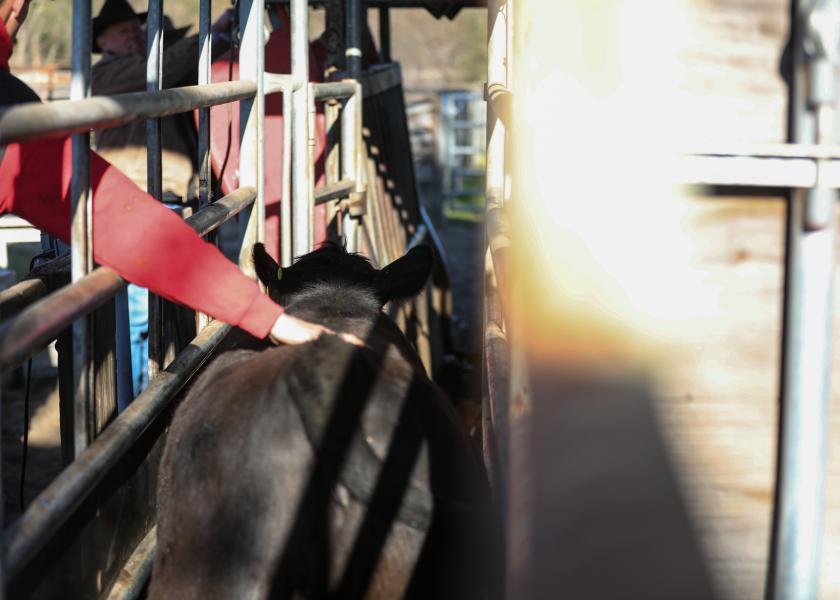Use Your Senses When Handling Cattle

Humans developed over millennia to hunt and herd. When it’s time to move animals, instincts send us out with a purpose but sometimes little thought to how our aggressive behavior affects what they do.
Stepping into a cattle pen, we naturally act the predator, manipulating where animals go. But good handling practices should turn us into leaders, says Kip Lukasiewicz.
The veterinarian now works through Production Animal Consultation to teach ranchers and cattle feeders across the country how to use their senses—sight, hearing, smell and touch—to understand and guide animals.
Study the behaviors
Rather than simply putting animals up front and pushing, a true communicator leads them through any facility or environment.
“I wish people could lose their voice,” Lukasiewicz says, “and learn to directly communicate with their eyes, their position and their posture.”
The shoulder, rib and hip are pressure points applied through body language. Response time is grounded in trust. Like a close friend, familiar cattle have a smaller flight zone and need more pressure to move. Less trust takes less pressure.
Disciplined learning
Special-forces military teams train to understand what another person is thinking, what they will do in any situation, to predict what will happen so there are no mistakes.
To work as a team, Lukasiewicz suggests new ranch hands watch and learn before stepping into the corral.
“A cow can focus on one or two people at a time,” he says.

Sorting pairs doesn’t take but two people. It helps ensure a quiet process that’s also efficient.
The USDA Meat Animal Research Center (MARC), with its 8,000-head cow herd and 6,400-head feedyard, is a testament to the benefits of a change in approach. In just six years working with Lukasiewicz, herd demeanor has changed dramatically, says MARC livestock manager Chad Engle.
He’s seen a difference across the 28 cattle breeds at MARC, with fewer accidents and injuries, too.
“Doctor Kip has evolved my thinking on training new employees,” he says. The need for experience on a resume has been replaced by “want to” in the interview.
Every win comes from disciplined action, and good stockmanship is no different.
“All professional athletes watch film of themselves,” he says. “And I consider myself a professional athlete at the end of the day.”
Visuals are still important to Lukasiewicz, whether it’s a drone shot above a facility or just watching cattle load out. How cattle behave as they move though pens or where they place their feet on unlevel ground tells what the animals need.
“By doing that, I designed a chute load-out with steps,” he says. “The width and depth of the steps gave more animal comfort as they were loading or coming off the truck.”
Being in the cattle business comes with high risk and investments.
“So make sure it’s right,” Lukasiewicz says.
The bottom line
“Good health isn’t secured with just a needle and syringe, it’s our approach,” Engle says.
Weaning starts the day a calf is born, in terms of how they’re handled and human interaction.
“It takes a skill that isn’t just born and natural,” he explains. “It takes being taught.”
Avoiding psychological pressure in stressful situations leads to more effective vaccine treatment.
“If we treat an animal, something went wrong in the system,” Engle says. “Not treating calves or having people get injured is hard to put a price tag on.”
When cattle have positive interactions with people, it’s more fun for everyone.
“I hope cattle enjoy our interaction,” says Byron Ford, a rancher and feeder near Cairo, Neb. “When you learn to work cattle this way, they look forward to seeing you.”
It makes his role as caregiver easier, too. Prey animals are experts at hiding sickness, so when they’re more comfortable it’s easier to find those having a bad day, Ford says.
Making big changes requires leader buy-in, and the leader isn’t always atop some corporate ladder.
“Sometimes the team leader isn’t the smartest or most well equipped,” Lukasiewicz says. “But they are the person that is relatable and inspiring.”
It just takes the action of one person to show others the way.
Related stories:







